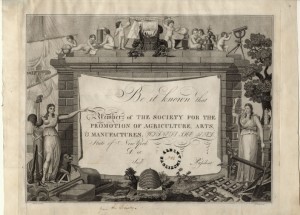Unprofessional Science

In a previous post, I mention the “professionalization of science,” a cultural shift in which Dudley had a part to play. It immediately raises the question, what exactly does “un-professional science” look like? What came before?
We actually have a good example here in the Capitol Region. Most readers will know of the Albany Institute of History and Art, the museum and cultural center a few blocks from the capitol. What many don’t know is that the museum has over 200 years of history. It began, not as a museum at all, but as a society for gentleman farmers.
It began in 1791 as the Society for the Promotion of Agriculture, Arts, and Manufactures, with the unfortunate acronym of SPAAM. It was organized by Chancellor Robert Livingston, owner of Clermont and large amounts of the Catskills, and included a number of big names from New York: Simeon Dewitt, the Surveyor General of New York State, and Ezra L’Hommedieu, a large landowner on Long Island. Later on, names like “DeWitt Clinton” and “Stephen van Rensselaer III” were added.
Along with meeting and events, SPAAM collected papers of interest and published them in their “Transactions …” Reading through gives us a good feel for what “unprofessional” science was like.

Many did good work, like Livingston’s discovery that seeding a field with gypsum improves the yield. Some of the results were comical, like lexicographer Noah Webster deciding that pine trees cause cold weather. But professional scientists made bad theoretical leaps in the early days as well. (Although probably none so bad as Livingston’s conviction that he could domesticate a moose.)
Probably the main thing worth noting is who was doing the science. Most of the names were wealthy people who had the time to experiment. Most of their work was tied to agriculture, so it also required a fair amount of land to experiment. Science was not their job; science was an acceptable hobby for gentlemen of leisure with enough land to commit to something unprofitable.
More than acceptable, it was actually a way for the American elite to signal that they didn’t have to work for a living. Like the Dowager Countess’ line in Downton Abbey, “What is a week-end?”, it was a way to show off you wealth and status without ostentation.
Many people wanted to get science out of the hands of these amateur gentleman farmers and into the hands of trained professionals. Of course, “trained professional” was a little sketchy. Since America had no universities that offered higher degrees in science until the late 19th century, the diploma couldn’t be used as a standard.
And of course, someone had to pay these professionals. That frequently meant convincing wealthy people that donating money to build an institution was the real path to status. This was particularly true in astronomy, where building large observatories and stocking them with expensive telescopes frequently required an extremely wealthy patron.
It was a slow process of building up institutions to train the professionals, building up the networks to employ the professionals and convincing everyone that professionals were the ones you wanted doing science. Here in Albany, the AIHA and Dudley represent two interesting examples of the early stages of this process.
